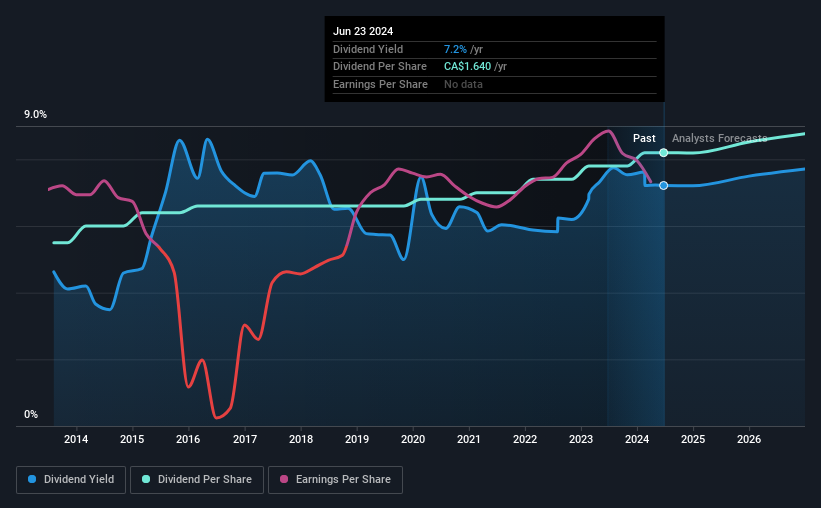
Readers hoping to buy Gibson Energy Inc. (TSE:GEI) for its dividend will need to make their move shortly, as the stock is about to trade ex-dividend. The ex-dividend date occurs one day before the record date which is the day on which shareholders need to be on the company's books in order to receive a dividend. It is important to be aware of the ex-dividend date because any trade on the stock needs to have been settled on or before the record date. This means that investors who purchase Gibson Energy's shares on or after the 28th of June will not receive the dividend, which will be paid on the 17th of July.
The company's next dividend payment will be CA$0.41 per share, on the back of last year when the company paid a total of CA$1.64 to shareholders. Last year's total dividend payments show that Gibson Energy has a trailing yield of 7.2% on the current share price of CA$22.73. If you buy this business for its dividend, you should have an idea of whether Gibson Energy's dividend is reliable and sustainable. We need to see whether the dividend is covered by earnings and if it's growing.
See our latest analysis for Gibson Energy
If a company pays out more in dividends than it earned, then the dividend might become unsustainable - hardly an ideal situation. Gibson Energy distributed an unsustainably high 147% of its profit as dividends to shareholders last year. Without more sustainable payment behaviour, the dividend looks precarious. Yet cash flow is typically more important than profit for assessing dividend sustainability, so we should always check if the company generated enough cash to afford its dividend. It paid out more than half (52%) of its free cash flow in the past year, which is within an average range for most companies.
It's good to see that while Gibson Energy's dividends were not covered by profits, at least they are affordable from a cash perspective. If executives were to continue paying more in dividends than the company reported in profits, we'd view this as a warning sign. Extraordinarily few companies are capable of persistently paying a dividend that is greater than their profits.
Click here to see the company's payout ratio, plus analyst estimates of its future dividends.

Have Earnings And Dividends Been Growing?
Businesses with strong growth prospects usually make the best dividend payers, because it's easier to grow dividends when earnings per share are improving. If earnings decline and the company is forced to cut its dividend, investors could watch the value of their investment go up in smoke. For this reason, we're glad to see Gibson Energy's earnings per share have risen 13% per annum over the last five years.
We'd also point out that Gibson Energy issued a meaningful number of new shares in the past year. Trying to grow the dividend while issuing large amounts of new shares reminds us of the ancient Greek tale of Sisyphus - perpetually pushing a boulder uphill.
Another key way to measure a company's dividend prospects is by measuring its historical rate of dividend growth. In the past 10 years, Gibson Energy has increased its dividend at approximately 4.1% a year on average. It's good to see both earnings and the dividend have improved - although the former has been rising much quicker than the latter, possibly due to the company reinvesting more of its profits in growth.
The Bottom Line
From a dividend perspective, should investors buy or avoid Gibson Energy? Growing earnings per share and a normal cashflow payout ratio is an ok combination, but we're concerned that the company is paying out such a high percentage of its income as dividends. While it does have some good things going for it, we're a bit ambivalent and it would take more to convince us of Gibson Energy's dividend merits.
However if you're still interested in Gibson Energy as a potential investment, you should definitely consider some of the risks involved with Gibson Energy. We've identified 4 warning signs with Gibson Energy (at least 1 which is a bit unpleasant), and understanding these should be part of your investment process.
If you're in the market for strong dividend payers, we recommend checking our selection of top dividend stocks.
New: Manage All Your Stock Portfolios in One Place
We've created the ultimate portfolio companion for stock investors, and it's free.
• Connect an unlimited number of Portfolios and see your total in one currency
• Be alerted to new Warning Signs or Risks via email or mobile
• Track the Fair Value of your stocks
Have feedback on this article? Concerned about the content? Get in touch with us directly. Alternatively, email editorial-team (at) simplywallst.com.
This article by Simply Wall St is general in nature. We provide commentary based on historical data and analyst forecasts only using an unbiased methodology and our articles are not intended to be financial advice. It does not constitute a recommendation to buy or sell any stock, and does not take account of your objectives, or your financial situation. We aim to bring you long-term focused analysis driven by fundamental data. Note that our analysis may not factor in the latest price-sensitive company announcements or qualitative material. Simply Wall St has no position in any stocks mentioned.
Have feedback on this article? Concerned about the content? Get in touch with us directly. Alternatively, email editorial-team@simplywallst.com
About TSX:GEI
Gibson Energy
Engages in the gathering, storing, optimizing, and processing of liquids and refined products in Canada and the United States.
Established dividend payer low.
Similar Companies
Market Insights
Community Narratives



